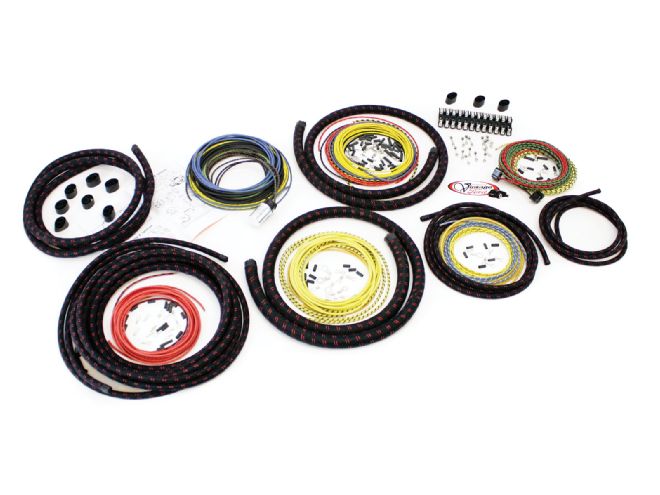
There was a time when a hot rodder copied a basic wiring diagram out of a motor's manual and bought the switches, relays, and connectors at the local auto parts store. The wire was what was available that day on the revolving rack of small wire rolls. Most budget-conscious guys only bought a few colors, which often made tracing a problem tougher later on. You didn't know if this one yellow wire was for the wiper or the starter solenoid.
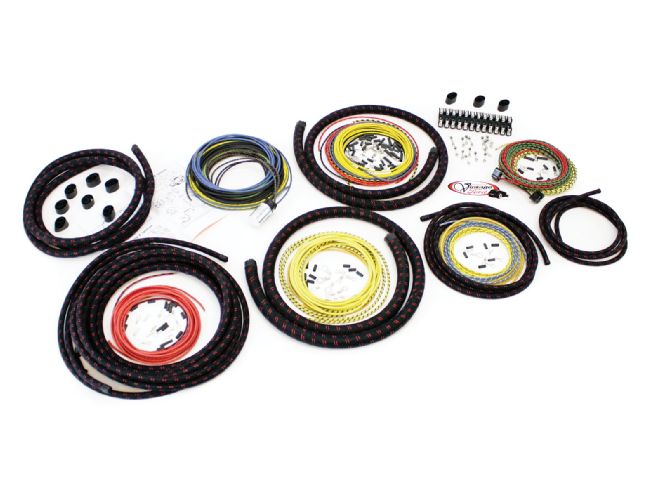 The wiring kit traditionalists have been waiting for is here. Each of the bundles you see here are sectional components of the kit with everything you need.
The wiring kit traditionalists have been waiting for is here. Each of the bundles you see here are sectional components of the kit with everything you need.
Kits and components aimed at such rodders building their own cars have been around for three or four decades. Considering that the evolution of wiring kits and the competition between many new companies vying for the customers, for the most part we now have many choices for quality kits and components. The instruction materials are decent, and the modern high-temperature, cross-link PVC insulation on today's wires is far superior in strength and heat-resistance to the wire-by-the-roll of the past.
As good as most kits are today, none so far serve the growing but admittedly smaller group of rodders building today's retro rods. The kits try to be applicable to all kinds of cars, so unless you're wiring a "modern" car, you always have to tie off lots of wires that aren't used. Most traditional rods do not have cruise control, power windows, power seats, stereo gear, A/C, backup lights, dome light, electric fan, third brake light, etc.
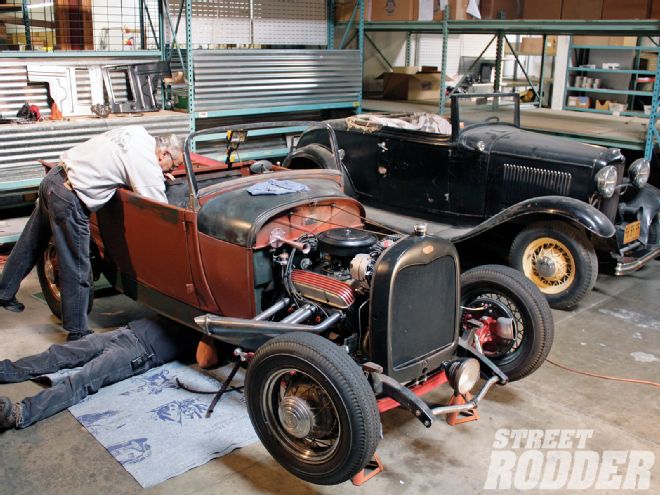 The test mule at Sacramento Vintage Ford has been Bud Bryan's new '29 rpu. Working under it is wiring guy and all-around genius, Ron Palmer.
The test mule at Sacramento Vintage Ford has been Bud Bryan's new '29 rpu. Working under it is wiring guy and all-around genius, Ron Palmer.
Traditional builders hide their modern plastic fuse panel, and disguise the too-colorful PVC wiring as best as possible with black tape; the better to maintain that '30s, '40s, or '50s vibe. Now, Sacramento Vintage Ford (Sacramento, CA) has provided just the solution for this group of young and old fans of the "way it used to be."
Outside of the world of original Ford Model A and V-8 restoration, most rodders have been unaware that inside the Sacramento Vintage Ford warehouse is a section called "production." This is where a staff of three men utilizes ancient machines to produce concours-stock, cloth-covered wiring harnesses for early Fords that feature all the correct terminals, brass bullet connectors, and other OEM details. Over the years, those "crossover" guys (lucky stiffs with both a restored Ford or two and a hot rod) would come to the counter at Sacramento Vintage Ford and ask why they couldn't get an old-school wiring harness for their hot rod.
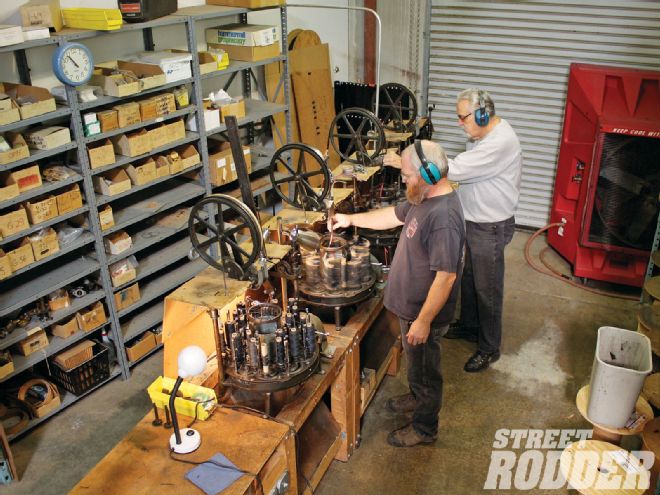 These braiding machines are over 100 years old! We love seeing old machines still doing what they were built for instead of melted down. When these things are running, there is clattering like 40 Model T con-rods, and watch your fingers.
These braiding machines are over 100 years old! We love seeing old machines still doing what they were built for instead of melted down. When these things are running, there is clattering like 40 Model T con-rods, and watch your fingers.
Now it happens that one of the people who make the Ford harnesses is our friend of 40 years, Bud Bryan, one of the pivotal editors of Rod & Custom, a man who was part of the R&C team that got '70-era rodders to start thinking about Flatheads, traditional cars, and long-distance driving to events. After a rod hiatus of eons, Bryan is finishing off a '29 roadster pickup full of collected old-school goodies. Bryan and Ron Palmer (the guy who keeps the harness machinery functional) were the most recent and final voices to be heard about making hot rod wiring kits with the cloth-covered wires and looms. The results are shown here.
Its name is the Vintage Hot Rod Wiring Kit (PN 17500), with an introductory price of $295. The beauty and practicality of the wires is that they are colored by the threads woven over the wires, so wires can be differentiated not just by garish plastic insulation colors as with other kits, but by a wide range of subtle designations, such as a pale yellow base with light green threads woven in as a tracer. The possible combinations of the basic thread colors and the tracers result in a wiring kit with little confusion. For instance, the horn button wire to the horn relay is a Yellow/2Green (two green tracers that cross) and there is no other wire used in the kit that is the same. With most other wiring kits, there could be half dozen red wires, but every wire in this kit has a different color, and can be told apart from any others without having to print the name of the destination all over the wire.
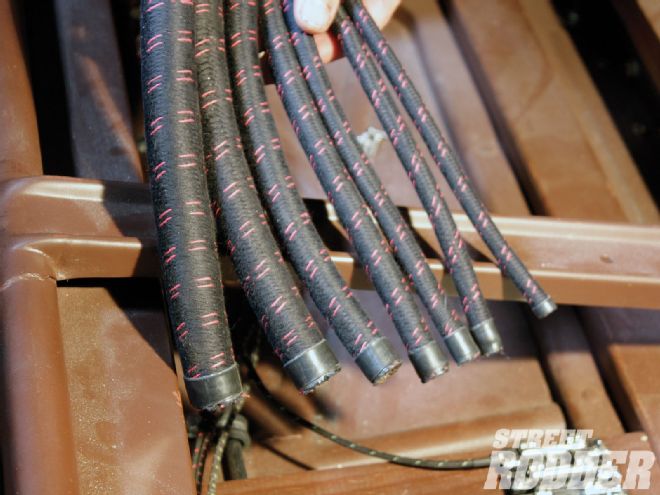 There are lots of choices in the wiring loom sizes, and they can be purchased separately in 6- and 12-foot lengths.
There are lots of choices in the wiring loom sizes, and they can be purchased separately in 6- and 12-foot lengths.
It should be understood that the wires used in the Sacramento Vintage Ford kit are modern in every way, except for the exterior cloth covering. The strength and heat-resistance qualities match any modern wiring kit. The cloth covering is coated with lacquer, just like the old days, which keeps the threads from fraying and makes the wires stay where you bend 'em better than just the plastic insulation.
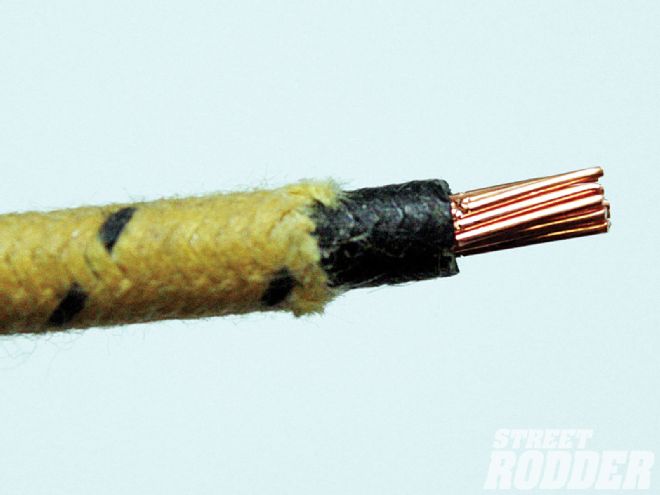 We've stripped back the cloth here on a piece of Sacramento Vintage wire. The black part between the colored threads and the stranded copper is the modern PVC insulation, which will normally not be seen.
We've stripped back the cloth here on a piece of Sacramento Vintage wire. The black part between the colored threads and the stranded copper is the modern PVC insulation, which will normally not be seen.
The business of keeping your wires tidy in a loom of some kind is just as necessary as in any other kit. Tubular loom material is important to protect and organize your wires. In this kit you'll find no crinkly plastic split-loom, but rather old-school loom just like the early Ford kits, with wound paper coated with tar and then covered with cloth. Sacramento Vintage Ford offers the loom material in seven diameters, from 3/16 inch for one or two wires to 3/4 inch for a big bundle. The entire loom for the hot rod kit is black with two red tracers.
The Vintage hot rod wiring kit divides the whole car into sections, each with the wires, terminals, loom, and a wiring diagram for that section in a bag, such as the "Turn, Tail, and Parking lights." There are two other cool features of this kit we like. There are separate "optional" bags of goodies depending on the variations, such as for use with a one-wire alternator, standard alternator, or a vintage generator with separate regulator.
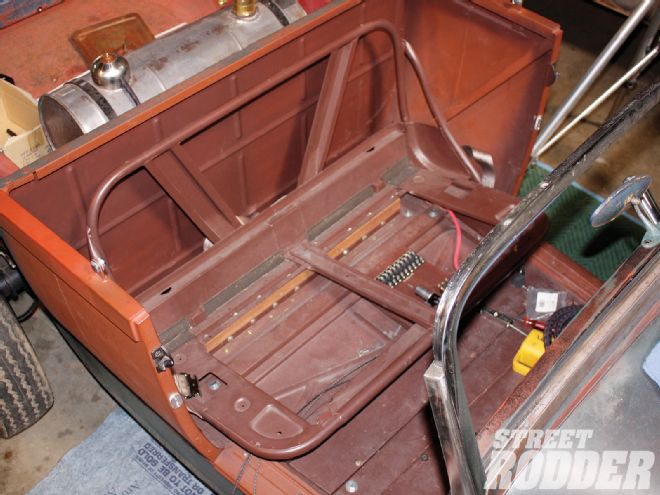 One of Bud's swap meet finds was this back seat frame from a '55 Chevy Suburban, which had to be narrowed somewhat and tilted back, but fits his 6-foot-plus self.
One of Bud's swap meet finds was this back seat frame from a '55 Chevy Suburban, which had to be narrowed somewhat and tilted back, but fits his 6-foot-plus self.
The other thing is that Sacramento Vintage Ford can help those guys who have already wired their car with a modern wiring kit, by offering 6- and 12-foot lengths of each size of their loom material and by-the-foot of any of their colors of cloth-covered wire. There are 29 different colors in 14 gauge, 11 colors in 12 gauge, and four colors in 10 gauge. Thus, a guy could get a few loom sizes and new wires to replace the modern ones that show in his engine compartment or at headlights, taillights, etc. The wire-by-the-foot ranges from $0.65 per foot to $0.95 (depending on the gauge) with a 10-foot minimum order. Note: when working with the loom tubing, be careful of abrading the covering at the ends, since this cloth is not lacquered. To cut it to the length you want, slide a piece of shrink-tubing over where you want to cut the loom, shrink it, then cut through the middle of the shrink-tube.
By the time you read this, Bryan will be out there amongst you again, drivin' the wheels off a traditional '29, though this time it'll be one that actually fits him (Brookville '29 rpu extra cab).